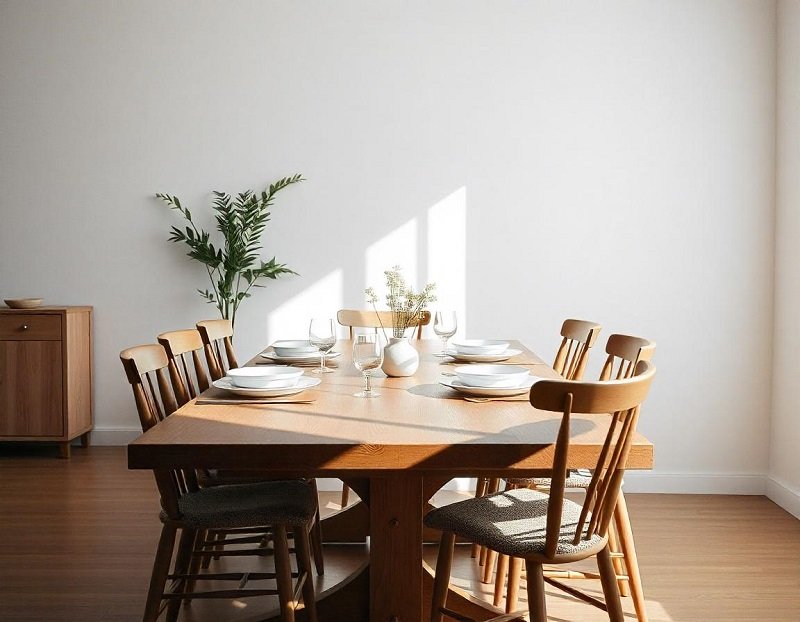Blog
How to Clean a Wooden Dining Room Table?

Introduction
Maintaining a wooden dining table can feel like caring for a family heirloom—both precious and timeless. And just like any treasured piece, it needs a little regular TLC to keep it looking its best for years to come. Whether your dining table is a rustic oak farmhouse model or a sleek walnut modern design, knowing how to clean and protect it properly can make all the difference in extending its life and preserving its beauty.
In this guide, we’ll walk you through the steps to clean your wooden dining room table, keeping it looking as radiant as the day you brought it home. We’ve got you covered from quick daily maintenance to deeper cleaning sessions. And don’t worry—it’s simpler than you think. No need for fancy cleaning solutions or complicated processes; it’s all about using the right techniques and materials to show your table some love.
Wipe Down the Table
There’s something almost meditative about the act of wiping down your table. After a meal, when the dishes are cleared and the remnants of a family gathering are still in the air, taking a soft cloth and gently cleaning the surface feels like closing a chapter. But this isn’t just about aesthetics—regularly wiping down your wooden dining table is the foundation for keeping it pristine over the years.
Start with the Right Cloth
To begin with, always use a soft, lint-free cloth. Microfiber works wonders for this because it picks up dust and small particles without scratching the surface. Picture it like the table’s own skincare routine—a soft microfiber cloth is the equivalent of a gentle exfoliant. It removes debris that could cause damage while leaving the surface smooth and polished. Using something too rough, like an old dish towel or paper towel, could leave behind tiny scratches, much like using a harsh scrub on delicate skin.
Dust with the Grain
Here’s a pro tip from our years of experience in furniture care: always dust in the direction of the wood grain. Think of the grain as the natural lines that define your table’s character. Dusting against it can push particles into the crevices while going with the grain ensures a smoother finish and keeps those little nooks and crannies clean. It’s like combing through your hair after a long day—you don’t want to fight against the natural flow.
A Daily Ritual for Long-Term Benefits
Incorporating a quick wipe-down into your daily routine isn’t just about maintaining appearances—it’s about preserving your table’s finish for the long haul. A few minutes each day can make a world of difference, much like brushing your teeth every morning keeps cavities at bay. You may not see the impact immediately, but over time, it pays off.
Make and Apply Your Cleaning Solution
Now that your table is free from surface dust and debris, it’s time to give it a deeper clean. But don’t reach for just any store-bought cleaner! Wooden furniture, especially dining tables that see regular use, requires special attention. The wrong product could strip the finish, leave unwanted residue, or worse, dry out the wood over time. Much like choosing the right moisturizer for your skin, picking the right cleaning solution can preserve the natural beauty and longevity of your table.
Choose a Gentle Cleaning Solution
Here’s where many people go wrong. They think the stronger the cleaner, the better the result. But that’s not the case with wood. Many harsh chemical cleaners can do more harm than good. You want to treat your wooden dining table with the same care you’d show to a cherished family antique, even if it’s brand new.
For most wooden tables, a mild, homemade solution will do the trick. A simple mix of warm water and a few drops of mild dish soap can work wonders. It’s a lot like making a gentle homemade cleanser for your skin—just enough to lift off grime without causing irritation or damage. This solution is mild enough for regular use but still effective at cutting through any grease or sticky residue left behind after meals.
How to Apply the Solution
Once your cleaning solution is ready, it’s time to apply it carefully. You don’t want to drench the table with water—that’s a surefire way to damage the wood. Instead, dampen your soft cloth (microfiber is great for this again) with the cleaning solution. Think of it like using a damp towel to gently clean a delicate surface. The goal is to lightly cleanse without saturating the wood.
Work in sections, especially if you have a larger table. This ensures you don’t miss any spots and allows you to focus on one area at a time. Gently wipe down the surface, following the grain of the wood, just as you did when dusting. Pay extra attention to areas where spills or sticky spots tend to accumulate, like the edges or near where the chairs meet the table. These spots are like the “T-zone” of your dining table, where oil and grime are most likely to build up.
Dry the Table
After you’ve cleaned your wooden dining table with a gentle solution, drying it thoroughly is just as important as the cleaning itself. Wood and water are a notoriously bad match, and leaving even a small amount of moisture on your table can cause long-term damage. Much like how you wouldn’t leave your skin damp after washing it—knowing it could lead to dryness or irritation—your table needs to be fully dried to maintain its luster and structural integrity.
Why Drying is Critical
Wood is a porous material, which means it can absorb moisture quickly. Over time, even minor exposure to water can lead to problems like warping, cracking, or unsightly water rings. You’ve probably seen these dreaded white rings on tables where someone placed a damp glass or hot dish without a coaster. This happens because moisture seeps into the wood’s surface, damaging the protective finish.
How to Properly Dry the Table
Grab a clean, dry microfiber cloth or any soft, absorbent fabric. Like when you’re drying delicate items of clothing, gently blot the table rather than scrubbing it dry. This ensures you’re not only absorbing all the moisture but also avoiding any unnecessary friction that could damage the wood’s finish.
Pay close attention to areas where water might have pooled—corners, grooves, or any detailed designs on the table surface. Even a little bit of water can seep into those spots, leading to long-term damage. I like to think of this step as a final “polish” after cleaning. As you wipe the table dry, you’re also enhancing the shine and ensuring that your hard work pays off with a spotless, gleaming surface.
Smart Tips for Cleaning & Protecting Your Wood Table
Now that we’ve covered the essentials of wiping, cleaning, and drying, let’s dive into some expert tips to keep your table in the best condition possible. Your dining table is more than just a piece of furniture; it’s a hub for family meals, celebrations, and countless memories. That’s why it’s important to go beyond just cleaning—these extra tips will help you protect your table from everyday wear and tear, keeping it in top shape for years to come.
- Regular Dusting
While we’ve touched on this briefly, it’s worth repeating: regular dusting is key to maintaining your table’s finish. Dust particles may seem harmless, but they can be abrasive. Imagine tiny grains of sand being rubbed into your table’s surface every time you set something down. By dusting frequently with a soft cloth, you’re removing those particles before they have a chance to do any damage. - Use Coasters and Placemats
This might seem like a no-brainer, but using coasters and placemats is one of the easiest ways to prevent water rings and heat damage. Much like applying sunscreen to protect your skin from the sun, coasters and placemats act as a barrier between your table and potentially harmful elements like hot dishes, cold glasses, or sharp cutlery. - Polish Your Table
Occasionally, you’ll want to polish your wooden dining table to restore its natural sheen. This is like giving your table a “spa treatment.” A good wood polish not only enhances the beauty of the grain but also adds a layer of protection against spills and stains. However, you don’t need to polish your table after every clean—once every few months is sufficient. - Use Tablecloths for Extra Protection
For special occasions or during times when you know the table will see heavy use, consider using a tablecloth. It’s like putting on a protective coat before heading out in the rain—it shields your table from spills, scratches, and general wear. Plus, with so many stylish options available, tablecloths can also add a touch of decor to your dining room while offering peace of mind.
Why I Don’t Use Vinegar to Clean My Wooden Furniture
- The Problem with Vinegar
The reason vinegar is so often recommended is because of its acidic nature. It can cut through grease and grime with ease, which makes it tempting to use on your dining table after a messy meal. However, wood is a much more sensitive material than hard surfaces like countertops or floors. The acidity in vinegar can break down the protective finish on your wooden dining table, leaving the wood exposed and vulnerable to scratches, stains, and other damage. - Safer Alternatives
Instead of vinegar, there are plenty of wood-specific cleaners on the market that are designed to clean and protect without stripping the finish. You can also opt for mild dish soap and water, as we discussed earlier, which provides a gentle yet effective way to clean your table without risking damage.
Conclusion
Cleaning and maintaining a wooden dining table doesn’t have to be a chore—it’s more about nurturing a piece of furniture that plays a significant role in your home. From family dinners to holiday feasts, your table is where memories are made, and with the right care, it can continue to serve as the heart of your dining room for generations to come.
By wiping down the table with care, using gentle cleaning solutions, and thoroughly drying the surface, you’re taking the necessary steps to protect your table from everyday wear. Avoiding common cleaning mistakes, like using vinegar, will help you preserve the beauty of your wood while following smart maintenance tips ensures your table stays in pristine condition for years.
FAQs
1- How often should I clean my wooden dining table?
You should wipe down your wooden dining table after every use, and deep clean it once a week to remove any buildup of dust, dirt, or oils.
2- Can I use a steam cleaner on my wooden dining table?
It’s not recommended to use steam cleaners on wood, as the high heat and moisture can damage the wood’s finish and cause warping.
3- What should I do if my wooden table has a scratch?
For light scratches, you can use a furniture marker or wax stick to cover the scratch. For deeper scratches, it may be necessary to sand and refinish the area.
4- Is it okay to use disinfecting wipes on a wooden table?
Disinfecting wipes can be too harsh on wood, especially if they contain alcohol or bleach. It’s better to use a wood-safe cleaner for disinfecting.
5- How can I protect my wooden table from heat damage?
Always use trivets or heat-resistant pads under hot dishes or cookware to prevent heat damage to your table.
6- Can I clean my wooden table with just water?
Yes, but be sure to use a damp cloth rather than soaking the table, and dry it thoroughly afterward to prevent water damage.
7- How do I remove water rings from my wooden table?
You can try using a mixture of baking soda and water to gently rub the area, or a small amount of toothpaste on a soft cloth.
8- Should I polish my wooden dining table regularly?
Polishing your table every few months can help restore its shine and protect the finish, but avoid over-polishing, as this can create a sticky buildup.
9- What’s the best way to store a wooden table when not in use?
If you’re storing your table, make sure it’s in a dry, climate-controlled space to avoid any moisture or humidity issues.
10- Can I use olive oil to polish my wooden dining table?
Olive oil can temporarily make the wood look shiny, but it’s not recommended for long-term use as it can leave a sticky residue and attract dust.






